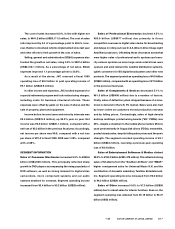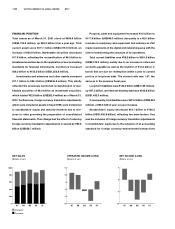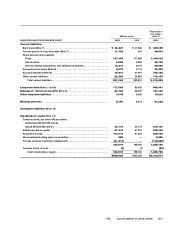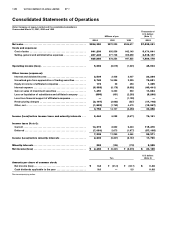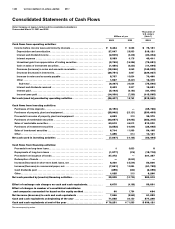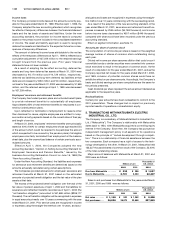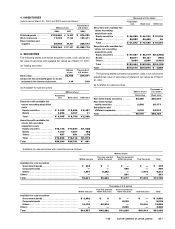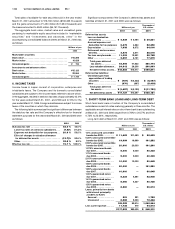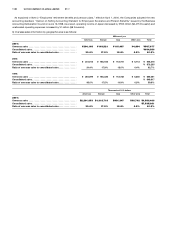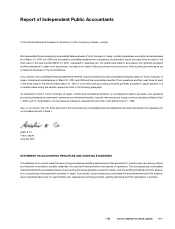JVC 2001 Annual Report Download - page 33
Download and view the complete annual report
Please find page 33 of the 2001 JVC annual report below. You can navigate through the pages in the report by either clicking on the pages listed below, or by using the keyword search tool below to find specific information within the annual report.
Securities
Prior to April 1, 2000, publicly-traded securities were stated at the
lower of cost or market, and the other securities were stated at cost.
Cost was determined using the moving-average method. Securities
of consolidated subsidiaries in the United States were accounted for
in accordance with the Statement of Financial Accounting Standards
No. 115 by the Financial Accounting Standards Board.
Effective April 1, 2000, the Companies adopted the new Japanese
accounting standard for financial instruments (“Opinion Concerning
Establishment of Accounting Standard for Financial Instruments”
issued by the Business Accounting Deliberation Council on January
22, 1999).
Upon applying the new accounting standard, all companies are
required to examine the intent of holding each security and classify
those securities as (a) securities held for trading purposes (hereafter,
“trading securities”), (b) debt securities intended to be held to maturity
(hereafter, “held-to-maturity debt securities”), (c) equity securities
issued by subsidiaries and affiliated companies, and (d) for all other
securities that are not classified in any of the above categories
(hereafter, “available-for-sale securities”).
Trading securities are stated at fair market value. Gains and losses
realized on disposal and unrealized gains and losses from market
value fluctuations are recognized as gains or losses in the period of
the change. The Companies had no held-to-maturity debt securities.
Equity securities issued by subsidiaries and affiliated companies which
are not consolidated or accounted for using the equity method are
stated at moving-average cost. Available-for-sale securities with avail-
able fair market values are stated at fair market value, Unrealized
gains and unrealized losses on these securities are reported, net of
applicable income taxes, as a separate component of stockholders’
equity. Realized gains and losses on sale of such securities are com-
puted using moving-average costs. Other securities with no avail-
able fair market value are stated at moving-average costs.
If the market value of equity securities issued by unconsolidated
subsidiaries and affiliated companies, and available-for-sale securities,
declines significantly, such securities are stated at fair market value
and the difference between fair market value and the carrying amount
is recognized as loss in the period of the decline. If the fair market
value of equity securities issued by unconsolidated subsidiaries and
affiliated companies not on the equity method is not readily avail-
able, such securities should be written down to net asset value with
a corresponding charge in the income statement in the event net
asset value declines significantly.
As a result of adopting the new accounting standard for financial
instruments, income before income taxes increased by ¥1,484 million
($11,968 thousand). Also, based on the examination of the intent of
holding each security upon application of the new accounting stan-
dard on April 1, 2000, trading securities as well as available-for-sale
securities maturing within one year from the balance sheet date are
included in current assets, and other securities are included in
investments and advances. As a result, at April 1, 2000, securities in
current assets decreased by ¥6,013 million ($48,492 thousand) and
investment securities increased by the same amount compared with
what would have been reported under the previous accounting policy.
Derivatives and hedge accounting
The new accounting standard for financial instruments, effective from
the year ended March 31, 2001, requires companies to state deriva-
tive financial instruments at fair value and to recognize changes in
the fair value as gains or losses unless derivative financial instru-
ments are used for hedging purposes.
If derivative financial instruments are used as hedges and meet
certain hedging criteria, the Companies defer recognition of gains
or losses resulting from changes in fair value of derivative financial
instruments until the related losses or gains on the hedged items
are recognized.
However, in cases where forward foreign exchange contracts are
used as hedges and meet certain hedging criteria, forward foreign
exchange contracts and hedged items are accounted for in the
following manner:
1. If a forward foreign exchange contract is executed to hedge an
existing foreign currency receivable or payable,
(a) the difference, if any, between the Japanese yen amount of the
hedged foreign currency receivable or payable translated using
the spot rate at the inception date of the contract and the book
value of the receivable or payable is recognized in the income
statement in the period which includes the inception date, and
(b)the discount or premium on the contract (that is, the difference
between the Japanese yen amount of the contract translated
using the contracted forward rate and that translated using the
spot rate at the inception date of the contract) is recognized in
the period which includes the inception date.
2. If a forward foreign exchange contract is executed to hedge a future
transaction denominated in a foreign currency, the future transaction
will be recorded using the contracted forward rate, and no gains or
losses on the forward foreign exchange contract are recognized.
Also, if interest rate swap contracts are used as hedges and meet
certain hedging criteria, the net amount to be paid or received under
the interest rate swap contract is added to or deducted from the inter-
est on the assets or liabilities for which the swap contract was executed.
Property, plant and equipment
Property, plant and equipment is stated at cost. Depreciation is
computed primarily by the declining-balance method based on the
estimated useful lives of the assets.
The ranges of useful lives for computing depreciation are generally
as follows:
Buildings 20 to 50 years
Machinery and equipment 3 to 7 years
Expenditures for maintenance and repairs are charged to income
as incurred.
Software costs
In accordance with the provisional rule of the JICPA’s Accounting
Committee Report No. 12, “Practical Guidance for Accounting for
Research and Development Costs, etc.” (the “Report”), the Company
accounts for software which was included in long-term prepaid
expenses in investments and other in the same manner in 2000 as in
1999. Pursuant to the Report, however, the Company included soft-
ware in other assets in 2001 and 2000. Software costs are amortized
using the straight-line method over the estimated useful lives (three
to five years). The amount for 1999 has been reclassified to conform
to the 2001 and 2000 presentation.
Finance leases
Finance leases, except those leases for which the ownership of the
leased assets is considered to be transferred to the lessee, are
accounted for in the same manner as operating leases.
Research and development
Research and development expenditures for new products or
improvement of existing products are charged to income as incurred.
< 30 VICTOR COMPANY OF JAPAN, LIMITED 31 >


